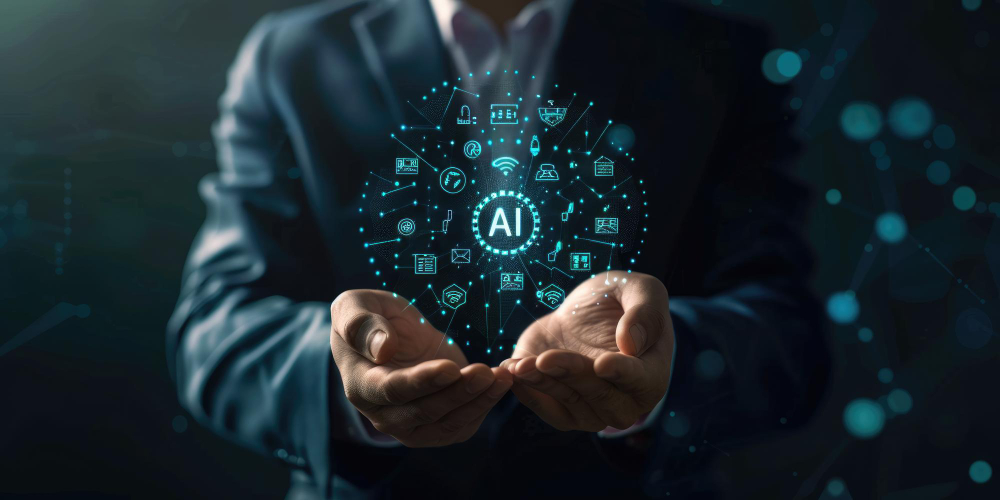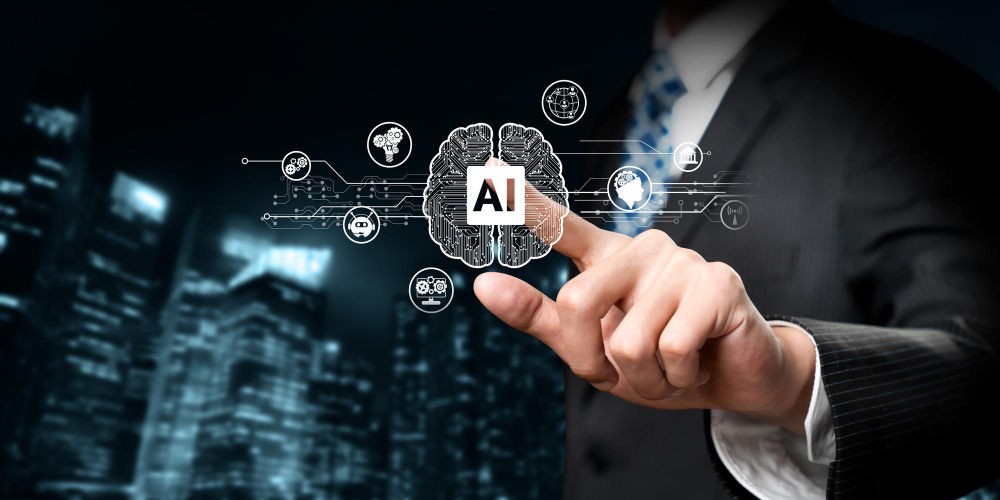Introduction:
Artificial Intelligence (AI) is rapidly transforming industries and reshaping our world. From diagnosing diseases to driving autonomous vehicles, AI is revolutionizing how we live and work. In this comprehensive guide, we’ll delve into the details of AI, exploring its history, applications, benefits, and challenges.
What is Artificial Intelligence (AI)?

Artificial Intelligence (AI) refers to the development of computer systems capable of performing tasks that traditionally require human intelligence. These tasks encompass a wide range of activities, such as learning from experience, reasoning to solve complex problems, understanding and processing language, perceiving and interpreting visual information, and even making decisions based on available data.
Take healthcare as a prime example: AI algorithms can sift through thousands of medical images in seconds, detecting early signs of conditions like cancer with precision that significantly outpaces traditional methods. By accelerating diagnostics and enhancing accuracy, AI not only transforms patient care but also sets new standards for medical excellence.
AI’s ability to process vast amounts of data, recognize intricate patterns, and make informed decisions is revolutionizing industries, driving efficiency, and enabling new possibilities that were previously unattainable.
The Evolution of AI: A Quick Overview:

Artificial Intelligence (AI) has evolved from a theoretical concept to a transformative force reshaping industries. Here’s a snapshot of key milestones in AI’s journey:
Early Foundations (1940s-1950s)
- Turing Test (1950): Alan Turing introduced the idea that machines could simulate human intelligence, laying the groundwork for AI.
- Dartmouth Conference (1956): The term “artificial intelligence” was coined, marking the birth of AI as a field.
Early AI Programs (1950s-1970s)
- Logic Theorist (1955): One of the first AI programs, capable of proving mathematical theorems.
- ELIZA (1966): An early chatbot that simulated conversation, pioneering natural language processing.
AI Winter (1970s-1980s)
- Decline: AI faced setbacks due to limited capabilities, leading to reduced funding and interest.
- Expert Systems (1980s): Rule-based systems revived AI, demonstrating commercial applications.
Machine Learning Emerges (1990s-2000s)
Learn More about What is Machine Learning?
- Neural Networks (1986): Advances in learning algorithms revitalized AI, improving tasks like image and speech recognition.
- Deep Blue (1997): IBM’s AI defeated world chess champion Garry Kasparov, showcasing AI’s strategic potential.
Big Data and Deep Learning (2010s-Present)
- Big Data Boom: The rise of big data and computing power accelerated AI’s growth, enabling breakthroughs in various fields.
- AlphaGo (2016): AI’s victory in the complex game of Go demonstrated its advanced capabilities.
Current and Future Prospects
- Generative AI (2020s): New AI models like GPT are revolutionizing content creation across industries. Learn more about Generative AI
- AI’s Future: The AI industry is set to explode, with projected revenues of US$ 1.8 trillion by 2030, growing at a CAGR of 37.3% from 2024-2030.
AI’s evolution reflects continuous innovation and its increasing impact on society. As it advances, AI will continue to drive transformative changes across various sectors.
Examples of AI Technology and Its Current Uses:

AI technology is deeply integrated into everyday life, often in ways we might not even notice. Here are some prominent examples:
- Virtual Assistants: AI-driven virtual assistants like Siri, Alexa, and Google Assistant manage tasks, set reminders, and answer questions through voice recognition and natural language processing (NLP).Learn the difference between Virtual Agents, Chatbots, and Virtual Assistants
- Recommendation Systems: Platforms like Netflix and Spotify use AI to analyze user preferences and behaviors, delivering personalized content recommendations.
- Autonomous Vehicles: AI powers self-driving cars, enabling them to navigate, detect obstacles, and make real-time decisions for safe travel.
- Healthcare: AI supports medical professionals by diagnosing diseases, predicting patient outcomes, and tailoring personalized treatment plans.
- Customer Service: AI chatbots and automated support systems provide quick, accurate responses, enhancing customer experience and efficiency.
These examples highlight how AI seamlessly integrates into various aspects of our lives, driving innovation and improving daily experiences.
How Does AI Work?

AI operates through advanced algorithms that process vast amounts of data, learn from it, and make intelligent decisions or predictions. The primary components that drive AI include:
- Machine Learning (ML): A core branch of AI focused on creating algorithms that enable systems to learn from data and improve over time without explicit programming. This is achieved through techniques like supervised learning, unsupervised learning, and reinforcement learning.
- Deep Learning: A sophisticated subset of ML that utilizes artificial neural networks with multiple layers (“deep” networks). These networks excel at analyzing complex, high-dimensional data, making deep learning essential for tasks like image recognition, speech processing, and autonomous driving.
- Natural Language Processing (NLP): A specialized AI technology that enables machines to understand, interpret, and generate human language. NLP powers applications like chatbots, language translation services, and sentiment analysis.
- Computer Vision: This field of AI focuses on enabling machines to interpret and understand visual information from the world, such as images and videos. Computer vision is fundamental to applications like facial recognition, object detection, and autonomous vehicles.
By integrating these technologies, AI systems can perform tasks autonomously, augment human capabilities, and assist in making more informed decisions. These components work in harmony to enable AI to tackle complex challenges and provide solutions across various industries.
Types of Artificial Intelligence: A Fascinating Journey Through AI Capabilities:

Artificial Intelligence (AI) manifests in various forms, each with distinct abilities and potential. Here’s an exploration of the different types, ranging from the practical to the speculative:
Narrow AI (Weak AI):
- What It Is: Narrow AI operates like a specialized tool, adept at performing specific tasks such as voice recognition or personalized recommendations. It excels in its niche but lacks the capability to generalize beyond its set function.
- Examples: Siri, Alexa, and Netflix’s content recommendation system.
- Tech Insight: Utilizes machine learning algorithms, often trained on large datasets, to achieve high performance in designated tasks. However, it cannot adapt its skills to unrelated areas.
General AI (Strong AI):
- What It Is: Envision an AI with the ability to understand, learn, and adapt across a wide array of tasks, similar to human cognitive abilities.
- Reality Check: This type remains theoretical, representing the long-term aspiration of AI research.
- Tech Insight: Developing General AI involves advancing neural networks and cognitive architectures to emulate human thought processes and reasoning across diverse contexts.
Superintelligent AI:
- What It Is: The ultimate in AI evolution, Superintelligent AI would exceed human intelligence in all aspects, including creativity, problem-solving, and strategic decision-making.
- Reality Check: Currently speculative and explored mainly in theoretical and ethical discussions.
- Tech Insight: Achieving Superintelligent AI requires breakthroughs in AI alignment and advanced neural network designs to ensure that such intelligence operates safely and ethically.
Reactive Machines:
- What It Is: The most basic form of AI, Reactive Machines operate purely based on current inputs without any memory of past experiences.
- Examples: IBM’s Deep Blue chess computer, which evaluates moves based on the current game state without historical context.
- Tech Insight: Relies on predefined rules and decision trees, offering specialized performance for specific tasks but with no learning capability.
Limited Memory AI:
- What It Is: Capable of learning from historical data to improve future performance, Limited Memory AI systems can adapt based on past experiences.
- Examples: Self-driving cars that analyze road conditions and traffic patterns to enhance their navigation over time.
- Tech Insight: Utilizes reinforcement learning and recurrent neural networks (RNNs) to analyze past data and refine decision-making processes.
Theory of Mind AI:
- What It Is: Aims to replicate human-like understanding of emotions, beliefs, and social interactions, creating more intuitive and empathetic interactions with humans.
- Reality Check: Still in the research phase, with significant advancements needed.
- Tech Insight: Involves developing affective computing and social intelligence technologies to enable machines to interpret and respond to human emotions and social cues.
Self-Aware AI:
- What It Is: Represents the pinnacle of AI development, where machines possess self-awareness and consciousness, understanding their own existence.
- Reality Check: Highly speculative and currently a topic of philosophical and ethical debate.
- Tech Insight: Would require creating systems with introspective capabilities, autonomous decision-making, and an understanding of their own state of being.
These AI types showcase a spectrum from today’s practical applications to ambitious future goals, reflecting the ongoing advancements and aspirations within the field of artificial intelligence.
Applications and Use Cases for Artificial Intelligence Across Industries:

AI is reshaping industries globally, enhancing daily conveniences and driving innovation. Here’s how AI is making an impact:
Healthcare: Revolutionizing Patient Care
AI in healthcare is like having a supercharged assistant, analyzing medical data to diagnose diseases, predict patient outcomes, and personalize treatment plans.
- Examples: AI-powered diagnostic tools that identify conditions from medical images, predictive models for patient risk assessment, and chatbots that offer initial consultations.
- Impact: Accelerates diagnosis, improves treatment accuracy, and enhances patient outcomes by leveraging vast amounts of medical data.
Finance: Enhancing Security and Decision-Making
AI in finance acts as a vigilant guardian, detecting fraudulent activities, automating trading strategies, and personalizing financial advice.
- Examples: Algorithmic trading systems that analyze market trends, fraud detection systems that identify suspicious transactions, and robo-advisors that provide tailored investment advice.
- Impact: Boosts financial security, optimizes investment strategies, and offers personalized financial management.
Retail: Transforming Customer Experiences
AI in retail is like a personal shopper, offering personalized recommendations, optimizing inventory management, and enhancing the overall shopping experience.
- Examples: Recommendation engines that suggest products based on past purchases, AI-driven chatbots that assist with customer queries, and inventory systems that predict stock levels.
- Impact: Increases sales through personalized shopping experiences, improves inventory efficiency, and enhances customer satisfaction.
Manufacturing: Boosting Efficiency and Innovation
AI in manufacturing functions as a precision tool, optimizing production processes, predicting equipment failures, and enhancing supply chain management.
- Examples: Predictive maintenance systems that foresee equipment breakdowns, AI-powered quality control systems, and smart supply chain management solutions.
- Impact: Reduces downtime, improves product quality, and streamlines supply chain operations.
Transportation: Pioneering Autonomous Solutions
AI in transportation is driving the future, enabling self-driving vehicles, optimizing route planning, and enhancing traffic management systems.
- Examples: Autonomous vehicles that navigate and drive without human intervention, AI systems for real-time traffic monitoring, and route optimization algorithms.
- Impact: Enhances road safety, reduces travel time, and improves overall transportation efficiency.
Education: Personalized Learning Experiences
AI in education serves as a tailored tutor, offering personalized learning experiences, automating administrative tasks, and providing insights into student performance.
- Examples: Adaptive learning platforms that adjust content based on student progress, AI-powered grading systems, and virtual tutors that assist with learning.
- Impact: Supports individualized learning, reduces administrative burdens, and provides valuable insights into student achievements.
Customer Service: Elevating Support Interactions
AI in customer service is like a 24/7 support agent, handling customer inquiries, automating responses, and providing quick, accurate assistance.
- Examples: AI chatbots that resolve common customer issues, virtual assistants that manage service requests, and sentiment analysis tools that gauge customer satisfaction.
- Impact: Enhances customer service efficiency, reduces response times, and improves overall customer satisfaction.
AI’s influence spans across industries, driving innovation, efficiency, and personalization. As technology advances, the scope of AI applications continues to expand, offering exciting possibilities for the future.
The Benefits of AI: Unlocking Potential and Driving Innovation:

Artificial Intelligence (AI) is more than just a technological marvel—it’s a game-changer with profound benefits that are transforming industries and improving lives. Here’s why AI is capturing so much attention and making such a significant impact:
Enhanced Efficiency: Streamlining Operations
- What It Does: AI automates repetitive tasks, speeds up processes, and reduces human error, leading to greater operational efficiency.
- Example: In manufacturing, AI-driven robots handle assembly lines with precision, while AI systems in finance automate data processing and transactions.
- Benefit: Saves time, reduces costs, and increases productivity by taking over mundane tasks and optimizing workflows.
Data-Driven Insights: Making Smarter Decisions
- What It Does: AI analyzes vast amounts of data to uncover patterns, trends, and insights that inform strategic decision-making.
- Example: Retailers use AI to analyze customer behavior and preferences, leading to more effective marketing strategies and product recommendations.
- Benefit: Provides actionable insights that enhance decision-making, allowing businesses to respond more effectively to market demands and customer needs.
Personalization: Tailoring Experiences
- What It Does: AI customizes experiences and recommendations based on individual preferences and behaviors.
- Example: Streaming services like Netflix and Spotify use AI to suggest content tailored to your tastes, while e-commerce sites offer personalized shopping experiences.
- Benefit: Enhances user satisfaction by delivering content and services that align with personal preferences, leading to a more engaging and relevant experience.
Predictive Capabilities: Anticipating Needs
- What It Does: AI uses historical data and predictive models to forecast future trends and potential issues.
- Example: In healthcare, AI predicts patient outcomes and potential health issues before they arise, enabling proactive interventions.
- Benefit: Helps businesses and individuals anticipate needs, mitigate risks, and make informed decisions based on future predictions.
Improved Accuracy: Minimizing Errors
- What It Does: AI systems perform tasks with a high degree of accuracy and consistency, reducing the likelihood of human error.
- Example: AI-powered diagnostic tools in healthcare identify diseases from medical images with remarkable precision, improving diagnostic accuracy.
- Benefit: Enhances quality and reliability, leading to better outcomes and reduced error rates in various applications.
Cost Savings: Reducing Operational Costs
- What It Does: AI solutions often lead to significant cost reductions by automating processes and optimizing resource allocation.
- Example: AI chatbots handle customer service inquiries efficiently, reducing the need for large customer support teams.
- Benefit: Lowers operational costs by minimizing manual labor and improving resource efficiency.
Innovation: Driving New Possibilities
- What It Does: AI drives innovation by enabling the development of new products, services, and technologies.
- Example: AI is at the forefront of developing autonomous vehicles, intelligent personal assistants, and advanced robotics.
- Benefit: Opens up new opportunities for growth and advancement, leading to breakthroughs that push the boundaries of what’s possible.
AI is not just reshaping how we work and live; it’s unlocking new potentials and driving progress across all sectors. By harnessing its power, we’re stepping into a future filled with possibilities and improvements that make life smarter, more efficient, and more personalized.
AI Challenges and Risks: Navigating the Complex Landscape:

While Artificial Intelligence (AI) offers transformative benefits, it also brings forth a range of challenges and risks that need careful consideration. Here’s a look at some of the key issues:
Bias and Fairness: Ensuring Equitable Outcomes
- Challenge: AI systems can inherit and even amplify biases present in their training data, leading to unfair and discriminatory outcomes.
- Risk: Bias in AI can result in unequal treatment in areas like hiring, lending, and law enforcement.
- Mitigation: Implementing diverse datasets, regular audits, and transparency in AI development can help address bias and promote fairness.
Privacy and Security: Protecting Sensitive Information
- Challenge: AI systems often handle vast amounts of personal data, raising concerns about data privacy and security.
- Risk: Unauthorized access or misuse of data can lead to privacy breaches and identity theft.
- Mitigation: Employing robust encryption methods, access controls, and data anonymization can safeguard sensitive information.
Ethical Considerations: Navigating Moral Dilemmas
- Challenge: AI raises ethical questions about the use of technology in decision-making, surveillance, and autonomous systems.
- Risk: Unethical use of AI, such as in surveillance or autonomous weaponry, can have significant societal implications.
- Mitigation: Developing ethical guidelines, involving multidisciplinary teams in AI design, and ensuring accountability can guide responsible AI development.
Job Displacement: Managing Workforce Impact
- Challenge: Automation through AI can lead to job displacement and changes in employment patterns.
- Risk: Workers in certain industries may face job loss or a need for re-skilling to adapt to new roles.
- Mitigation: Investing in workforce development, reskilling programs, and creating new job opportunities can help mitigate the impact on employment.
Transparency and Explainability: Understanding AI Decisions
- Challenge: Many AI systems, especially those using deep learning, operate as “black boxes” with opaque decision-making processes.
- Risk: Lack of transparency can erode trust and make it difficult to understand and challenge AI decisions.
- Mitigation: Focusing on explainable AI models and providing clear documentation of AI processes can improve transparency and trust.
Regulatory and Legal Issues: Navigating Compliance
- Challenge: The rapid advancement of AI technology often outpaces existing regulations and legal frameworks.
- Risk: Organizations may face legal challenges and compliance issues due to outdated or unclear regulations.
- Mitigation: Engaging with policymakers, staying informed about emerging regulations, and adapting to new legal requirements can ensure compliance.
AI Safety and Control: Ensuring Reliable Operation
- Challenge: Ensuring that AI systems operate safely and reliably, especially in critical applications, is crucial.
- Risk: Faulty or unpredictable AI behavior can lead to accidents or system failures.
- Mitigation: Implementing rigorous testing, safety protocols, and fail-safes can help manage and control AI systems effectively.
Addressing these challenges and risks is essential for harnessing the full potential of AI while ensuring its responsible and ethical deployment. By proactively tackling these issues, we can shape a future where AI enhances human capabilities and drives positive change.
Scaling Up AI Efforts: From Ad Hoc Projects to Full Integration:

Transitioning from isolated AI initiatives to comprehensive, integrated AI solutions involves strategic planning and execution. Here’s how organizations can scale up their AI efforts effectively:
- Develop a Clear AI Strategy: Align AI initiatives with business goals and create a roadmap for implementation.
- Build a Strong Foundation: Invest in infrastructure, including data storage and AI tools.
- Foster a Data-Driven Culture: Promote data literacy and best practices across the organization.
- Integrate AI into Core Processes: Embed AI into workflows to enhance efficiency and decision-making.
- Leverage Cross-Functional Teams: Form teams with diverse expertise to address challenges and ensure alignment.
- Scale AI Models and Solutions: Transition from pilots to full-scale deployments, monitoring performance and adjusting as needed.
By strategically scaling AI efforts, organizations can maximize the benefits and drive significant advancements.
Elevate Your AI Journey with advansappz:
Unlock the full potential of artificial intelligence for your business with our expert solutions. Here’s how we can transform your AI initiatives from initial concepts to impactful solutions:
AI Strategy Development:
- Collaborate to create a strategic AI roadmap that aligns with your business goals. Identify key opportunities, set actionable objectives, and ensure that your AI implementation delivers significant value.
Infrastructure and Technology Support:
- Utilize state-of-the-art infrastructure solutions, including scalable cloud services and advanced analytics platforms, to provide a robust foundation for your AI efforts.
Data Management and Analytics:
- Establish a data-driven culture by implementing best practices for data collection and analysis. Gain actionable insights and leverage data to drive strategic decisions.
Custom AI Solutions:
- Receive tailored AI solutions that seamlessly integrate with your existing processes. From customer service automation to predictive analytics, our solutions are designed to meet your specific needs.
Cross-Functional Team Integration:
- Facilitate effective collaboration between your technical and non-technical teams, ensuring AI projects are aligned with business objectives and executed efficiently.
Scalability and Performance Optimization:
- Focus on scaling AI models and solutions to meet growing demands, continuously optimizing performance to ensure efficiency and adaptability.
Governance and Compliance:
- Implement comprehensive governance frameworks to ensure ethical AI use, data privacy, and regulatory compliance, ensuring your AI systems are secure and transparent.
Continuous Improvement:
- Engage in ongoing evaluation and refinement of AI systems, adapting to technological advancements and evolving business needs to maximize ongoing value and innovation.
Talent and Skills Development:
- Access training and resources to enhance your team’s AI expertise, building and retaining a skilled workforce capable of driving AI success.
Ready to transform your business with cutting-edge AI solutions? Contact us today to explore how our expertise can drive your AI success.
Frequently Asked Questions (FAQs):
- What AI solutions does advansappz offer?
We offer custom AI development, machine learning models, natural language processing, and advanced analytics, all tailored to your business needs. - How do you ensure data security and privacy?
We use robust data governance practices, including encryption, access controls, and adherence to industry regulations, to safeguard your data. - Can you assist with scaling AI solutions?
Yes, we excel in scaling AI solutions from pilot phases to full deployments, optimizing performance and managing increasing data volumes. - How do you integrate AI into existing processes?
Our team integrates AI solutions into your core business processes with minimal disruption, ensuring smooth and efficient implementation. - What training and support do you offer?
We provide comprehensive training programs, workshops, and ongoing support to build your team’s AI expertise and ensure successful system management.












